Stem cells are undifferentiated cells in the class that distinguish the specialized cell types.Originate in the rule, which stem from two sources:

Blastocyst stage embryos were in embryonic development (embryonic stem cells) and formed
Adult tissues (stem cells).Both species are generally characteristic of the power, you can distinguish the different types of cells (eg skin, muscles, bones, etc.).In a normal pregnancy, and the maintenance of the blastocyst stage of embryo implantation in the uterus, according to the will of the embryo as the fruit. This usually happens at the end of 10 weeks of pregnancy, after all the main organs of the body was created.
But if the process of obtaining embryonic stem cells, the blastocyst stage by distinguishing the signs of stem cells from an "inner cell mass of blastocysts in the culture dish with nutrient-rich broth. Lack of stimulation, they begin to divide and proliferate, while the ability to any type of cell in the human body. Ultimately, these undifferentiated cells, stimulates the creation of special cells.
 Adult stem cells
Adult stem cells
Adult or somatic stem cells in the body after embryonic development and in different tissues.These stem cells found in tissues such as brain, bone marrow, blood, blood vessels, skeletal muscle, skin and liver. They remain at rest, or not distributed to the public year until the active disease or tissue damage.
Adult stem cells can divide and renew it indefinitely, so that they regenerate the creation of a variety of cell types in the original organ or entire body of the original. It is believed that the limited ability of adult stem cells differentiate on the basis that the tissue origin, but there are some who claim that distinguish different cell types, the article.
Embryonic stem cells
Embryonic stem cells from four to five days old human embryo, a blastocyst stage. General improvements in the IVF embryos (in vitro fertilization) clinics, where several implanted in-vitro fertilized eggs, but only one is in a woman.
Sexual reproduction begins when the sperm human eggs, the female (fertilized eggs) to a single cell called the zygote. Common cell zygote begins a series of chambers that are 2, 4, 8, 16 cells, four to six days - before implantation in the uterus - a mass of cells called blastocysts.Blastocyst) is the inner cell mass (cell mass) and the outer cell mass (trophoblast. Outer cell mass is a part of the placenta and the inner cell mass of a group of cells that distinguish all the structures of the adult body. The last mass is the source of embryonic stem cells - totipotent cells (cells with a total development potential of each cell in the body)
The culture of stem cells
Stem cells are not adult tissues, or derived from the division of the zygote in the culture dish.After extraction, scientists place the cells in a controlled culture prohibits them further specialization and differentiation, but generally they can divide and multiply. Process increasingly large number of embryonic stem cells is easier than ever before, that a large number of adult stem cells, but the progress of both cell types.
Stem Cell Lines
Once the stem cells were allowed to be transmitted and controlled distribution of strain collection of healthy, proliferating and undifferentiated cells, called stem cell lines. These cell lines and was later divided among researchers. When encouraged under control, stem cells can be specialized in the management of the researchers - a process known as directed differentiation. Embryonic stem cells can differentiate between different types of cells than adult stem cells.
Potency
Stem cells are by their ability to distinguish between different cell types classified. Embryonic stem cells is the strongest, as they should for all types of cells in the body. Full certification includes:
Totipotent - the ability to distinguish all possible types of cells. Examples of egg fertilization and zygote formation in the first cell division of the zygote.
Pluripotent - the ability to differentiate into nearly all cell types. Examples are the human embryonic stem cells and stem cells from the mesoderm, endoderm and ectoderm germ layer is derived in the early stages of differentiation of embryonic stem cells formed.
Multipotent - the ability to discriminate between closely related family of cells to differentiate.Examples include blood (adult) stem cells, the red and white blood cells or platelets.
Oligopotent - the ability to differentiate between different cells. Examples (adults), myeloid or lymphoid progenitor cells.
Unipotent - can produce only cells of their own species, but to identify the self-renewal of stem cells. Examples of the (adult) muscles.
Totipotent pluripotent embryonic stem cells, but not because they are not able to participate in extra-embryonic membranes and placenta.
No comments:
Post a Comment